Herman Willem Daendels
Marshal of Holland
Dutch Generals of the Napoleonic Wars
Introduction
by Geert van Uythoven, The Netherlands
| |
I think that the Napoleonic era has produced much more interesting personalities than those usually published, especially on the continent, many officers lead colourful lives. None the least because they had to change army from time to time (Clausewitz, Jomini, Yorck, Frederick of Orange to name but a few), but also because destiny took a part in their career. To illustrate this, I have written a biography of Daendels. I am sure many of you have not heard of him, but I hope that after reading it you are convinced of what I said. If your reactions are positive, I will gladly write more biographies, for example from the Prince of Orange, Admiral van Kinsbergen, General Dumonceau, Prince Frederick of Orange, General Chassé, General Constant Rebeque and General Perponcher. Also I would like to call on you Prussian, Russian, Swedish, etc., readers to sit down behind your computer (or take your pencil!) and surprise us with biographies of your national heroes!
Herman Daendels was born on 21 October 1762. He was the son of Burchard Johan Daendels, councillor and secretary of the city of Hattem, lying near the river IJssel in the province of Gelderland. His mother was Josina Christina Tulleken, daughter of a lawyer from the city Zutphen. After his elementary school he went in 1781 to the city of Harderwijk to study law at the University of Gelderland. He was a good student, and already on 10 April 1783 he became a Doctor of Law.
At this university Daendels became influenced by patriotic ideals. At this time the patriots gained more and more followers. The economy of the United Provinces was in decline. According to the patriots the main fault was with the political constitution: It needed reforming in such a way that the people would receive much more influence. Symbol of their hate was the Stadtholder, William V of Orange. He was the representative of the suppression of the people by the nobility.
Returning to Hattem, Daendels was an active propagandist of patriotic ideas. He also grounded, as was already done in many other cities, an exercitiegenootschap ('freecorps'). These societies practised drill and the use of side arms, and the members lectured in the ideals of the great philosophers and the North-Americans. The society in Hattem became more and more influence on the inhabitants, contrary to the other cities in the province Gelderland.
The sacking of Hattem that followed was one of the causes of growing resistance in the United Provinces. At last the real power was in the hands of the patriots. On 13 September 1787 26,000 Prussians invaded, the Prussian King feeling himself insulted because of the treatment his sister, wife of William V received from the patriots. Resistance was nearly non-existing. Only at the gates of Amsterdam did some fighting occur, where we find Daendels again, as a Major commanding the volunteers from Gelderland.
Before he left Daendels married Alida Elisabeth van Vlierden, without the consent of her father. They married in 9 March 1987 in Lage near Bentheim, Germany. They would have 15 (!) children.
During the first years of his exile Daendels busied himself with commerce. Also he united himself with five other exiles to form a 'Comité Revolutionair', to lead a movement for freeing the Fatherland. When King Louis XVI declared war to Austria on 20 April 1792, Daendels made plans to raise a Batavian Legion to fight for the French. Only 300 patriots came forward, and the Batavian Legion was incorporated with the 4th Infantry Battalion of the 'Légion Franche Etrangère'. The legion was organised along the same lines as the French army and consisted mainly of Belgians. It comprised at the beginning of 1793 four infantry battalions with some Jäger, four cavalry squadrons and the artillery with 28 light field guns, 2,450 men in all. Commander of the legion was the Polish Colonel Mascheck; being one of the leading exiled patriots, Daendels became on 12 October 1792 a French Lieutenant Colonel. He took part with the Legion in the battle of Jemappes (6 November 1792).
On 1 February 1793 the French declared war against Great Britain and the United Provinces. At last the time for the patriots had come to take revenge on the Orangists, and to 'liberate' their native country. On 16 February the French 'Armée du Nord', commanded by General Dumouriez, crossed the border. The advance guard consisted of the Legion, part of the Division Berneron. Breda, Klundert and Geertruidenberg were taken without much fighting, but the French could not cross the big rivers. The Legion took part in the taking of Klundert and the siege of Willemstad, and Daendels led in person an attack on Willemstad (3 March). Daendels also tried an attack, against the island of Dordrecht, with 800 men of the Legion (9 March), but was repulsed by the much stronger Anglo-Dutch garrison.
Dumouriez had to retreat after receiving news of the situation near the Meuse and was then defeated at Neerwinden (18 March), and in the end defected to the Allies. In the summer of 1793 the Legion was disbanded, and Daendels received command of a regular French battalion. He was, during his service in the French army, continuously in contact with the patriots in the United Provinces; these had to be 'liberated' from inside and not conquered by the French.
Almost Captured
On 18 August Daendels was nearly captured by Dutch troops in the action at Lincelles.
Daendels advocated the use of the bayonet, and his men used it often during the many actions he initiated, for example at Zandtvoorde (20 February 1794), Menin (28 February), Thébes (4 April), and other places. Because of his excellent behaviour, Daendels became in March commander of all the troops at the river Lijs. In April he gained promotion to Génèral de Brigade in Moreau's Division. Daendels advocated a strong discipline and suppressed looting. Because of this he repeatedly had words with General Vandamme, whose brigade showed especially bad behaviour.
Relations with Vandamme were bad. On 3 May Daendels was ordered by Moreau to unite with Brigade Vandamme and attack Rousselaere. Daendels send message to Vandamme that the Allies had planned an attack on Vandamme's Brigade, and advised him not to leave his position. Vandamme still moved with part of his force to combine with Daendels brigade, but on arrival learned that Daendels had already taken Rousselaere on his own, sustaining heavy losses in the process.
On 11 May Daendels and Vandamme were ordered to pursue the enemy. Vandamme would take the road to Brugge by way of Ingelmunster; Daendels would advance through the villages Lingelede and Iseghem. On their left the remainder of the French fought the battle of Courtray (Kortrijk). Vandamme made contact with the Allied rear-guard at Ingelmunster, but seeing he was not strong enough, retreated after taking 4 guns and 100 prisoners. Daendels heard the noise of the action and marched to the sound of the guns. Arriving near Ingelmunster he was promptly attacked in the flank by Austrian cavalry. His troops broke and Daendels was nearly killed. He was saved by Vandamme, who covered the retreat of his troops. Daendels fought on 29 April 1794 with much valour in the battle of Moucron, were the French won a victory over the Austrian General Clerfayt and took 1,200 prisoners, 33 guns and 4 colours.
On 18 May 1794 Daendels took part in the battle of Tourcoing (Doornik), were he commanded the left wing. This was the second great French victory of the year: the Allies lost 4,100 men and 30 guns. Then he very ably took part in covering the French forces that were besieging Ypres (Yperen): combats of Hooglede on 10, 13 and 16 June. After the battle of Fleurus (26 June) the Austrians retreated to Germany. The Dutch and British troops were too weak to prevent a French advance and retreated fighting to the North. They were closely followed by the French. Daendels brigade, now part of Delmas' Division, stayed in the vicinity of Antwerp. On 17 August Daendels was nearly captured near St. Nicolaas by a Dutch patrol. During this time he was promoted to Major General.
Direct Attack
On 25 August Daendels left for Paris, to ask permission for Pichegru to use the Armée du Nord for a direct attack on the United Provinces. On 1 September he returned with a positive answer. On the 5th he moved with his brigade to the vicinity of Breda, were he took part in some minor actions. From there his brigade acted as an advance guard for the French, with on the 12th outposts at the rivers Kleine Aa and Beers. From there the advance continued. Delmas was ordered to take with his Division the city of s Hertogenbosch. This city had no chance against the French if these could take the fortress Crêvecoeur, because it controlled the inundation's around the city. On 27 September Daendels' Brigade appeared at the fortress, and fired on it with his 8pdr and 12pdr field guns. The same evening the commander of the fortress, Lieutenant Colonel Tiboel, surrendered and the heavy guns of the fortress were used to bombard 's Hertogenbosch. On 10 October the commander, the Prince of Hessen-Philipsthal, surrendered.
Pichegru was hesitating. To advance farther would mean the crossing of big rivers, with all chance of heavy opposition. So he decided to consolidate. This was not what Daendels wanted. He wanted to conquer the whole of the United Provinces, with or without Pichegru's help. So he tried to get permission from Paris, and sends proclamations to the patriots in the United Provinces to stand up against the government. Pichegru was not pleased with his difficult subordinate commander.
To get him out of the way, he promoted him to Génèral de Division and settled a transfer for him to the army of the Pyrenees. By way of influential political friends in Paris Daendels managed to postpone the transfer. The representatives attached to the Armée du Nord threatened Pichegru that they would accuse him with treason if he would not attack.
On 11 December Daendels tried to gain a foothold on the other side of the river near Crevecoeur, twice the French reached the other side, but both times they were thrown back with heavy losses. On the 22nd another attack from Daendels near Kapelle failed.
On 27 December the attack at last succeeded. This time providence helped: the winter was the worst of the century. The rivers froze, and the ice was strong enough to cross even with the artillery. Daendels crossed the river Meuse first, south of Empel. His soldiers, who were preceded by patriots clothed as farmers, surprised the Dutch outposts at Casperhoef (09.00am), and thus allowed Daendels' Brigade to cross unopposed. At Wel and Hedel some fighting occurred, but eventually Daendels, supported by the Brigade Winter - which crossed a few hours later near Alem - captured the island of Bommelerwaard 1.
The British choose not to hold this line, and started their retreat to the North on 3 January 1795. They were closely followed by French patrols, guided by patriots. Daendels meanwhile had moved with his brigade to besiege Heusden. On 11 January 1795 his batteries opened fire, and already two days later Heusden surrendered, although the garrison was 1,400 men stronger than Daendels troops! Again a sign of the bad morale of the Allied, and especially the Dutch troops. Then he also advanced across the rivers into the heart of the United Provinces, sending letters to the cities to free themselves from the reign of the stadtholder.
More Daendels
|

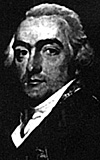 Interest in the biographies of Napoleonic Generals is growing. Sadly, most of those published are of Napoleon's own Marshals and Generals. Although these are famous for their part in history, their lives were mostly one of moving from one battlefield to another, were born poor, fought well, were wounded, and in the end grew tired of fighting.
Interest in the biographies of Napoleonic Generals is growing. Sadly, most of those published are of Napoleon's own Marshals and Generals. Although these are famous for their part in history, their lives were mostly one of moving from one battlefield to another, were born poor, fought well, were wounded, and in the end grew tired of fighting.
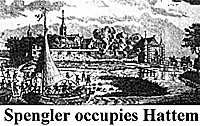 The climax came in 1786. The government of the United Provinces ordered Major General Spengler to restore order at Hattem, which had become completely patriotic. Spengler had with him two infantry regiments, ('Plettenberg' and 'Sommerlatte', a cavalry troop from the Regiment 'Tuill van Serooskerken' and an artillery detachment. Daendels was strengthening the defences of Hattem, and was reinforced with members of the Free Corps of other cities. He even managed to obtain from Zwolle some guns with ammunition. After some skirmishing the Government troops stormed the gate and took Hattem without loss, most of the patriots having already taken flight, so actually there was not much fighting.
The climax came in 1786. The government of the United Provinces ordered Major General Spengler to restore order at Hattem, which had become completely patriotic. Spengler had with him two infantry regiments, ('Plettenberg' and 'Sommerlatte', a cavalry troop from the Regiment 'Tuill van Serooskerken' and an artillery detachment. Daendels was strengthening the defences of Hattem, and was reinforced with members of the Free Corps of other cities. He even managed to obtain from Zwolle some guns with ammunition. After some skirmishing the Government troops stormed the gate and took Hattem without loss, most of the patriots having already taken flight, so actually there was not much fighting.
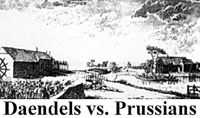 On some improvised gunboats near the Duivendrechter bridge he fires on the Prussians that advance along the dike. However, the Prussians were much to strong, and after some loss on both sides the volunteers take flight. The Stadtholder was reinstalled. Daendels had no other choice than to go in exile to France.
On some improvised gunboats near the Duivendrechter bridge he fires on the Prussians that advance along the dike. However, the Prussians were much to strong, and after some loss on both sides the volunteers take flight. The Stadtholder was reinstalled. Daendels had no other choice than to go in exile to France.
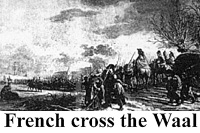 The French took 1,600 prisoners and 60 guns. Daendels followed up his success, crossed also the Waal and entrenched himself near Tuil. Pichegru surprised by the unexpected success did not support Daendels on the other side of the river. Daendels refused to retreat, and had to fight on the 28th a desperate battle with about 2,000 men to maintain his bridgehead against the British brigade Dundas and some Hessian battalions (17 battalions, 10 squadrons and 3 artillery batteries). In the afternoon he was reinforced by troops under Brigade General Salm.
The French took 1,600 prisoners and 60 guns. Daendels followed up his success, crossed also the Waal and entrenched himself near Tuil. Pichegru surprised by the unexpected success did not support Daendels on the other side of the river. Daendels refused to retreat, and had to fight on the 28th a desperate battle with about 2,000 men to maintain his bridgehead against the British brigade Dundas and some Hessian battalions (17 battalions, 10 squadrons and 3 artillery batteries). In the afternoon he was reinforced by troops under Brigade General Salm.
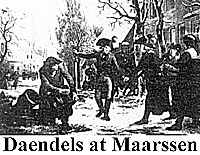 On 17 January the stadtholder and his family went into exile in Great Britain; resistance had become useless, with more and more inhabitants choosing the side of the patriots. A day later Daendels entered Amsterdam. His goal was reached, the United Provinces were 'liberated'.
January 1795; Daendels at the village Maarssen.
On 17 January the stadtholder and his family went into exile in Great Britain; resistance had become useless, with more and more inhabitants choosing the side of the patriots. A day later Daendels entered Amsterdam. His goal was reached, the United Provinces were 'liberated'.
January 1795; Daendels at the village Maarssen.